Galactic Civilizations III was released on May 14, 2015, developed and published by Stardock Entertainment. GalCiv 3 is a turn-based space 4X strategy games that has a focus on planetary management, star base construction, and the ability to design your own ships. The ship designer allows the player to almost create (or re-create) any visual ship design they wish. The game, as with its predecessors, shies away from having any form of tactical combat, but the role of the player in fleet construction has been significantly improved.
Overall, the game looks a lot like its forefather Galactic Civilizations II. This should not deceive the player from all the improvements the game does offer. Many systems, despite their immediate familiarity, have been improved significantly and the game boosts a few new features which still have their foot in the door for being connected to an older system. The game is also visually very stunning and rich in details. The series also finally allows the player to play online with friends with its new multiplayer mode.
However, this doesn’t mean the game doesn’t have its share of problems. Some minor polish issues which actually have some impact on gameplay, many of the weaker systems from the predecessor are either unchanged or feel like a step back, if not outright removed. The similarities may make it all too easy for someone to feel the game hasn’t evolved enough. It’s understandable why a more conservative approach was taken, but there were areas Stardock could have been a little more risqué in its design.
Presentation and Set-Up
The first thing anyone would notice is that the game is stunning. Comparable with AAA titles in presentation it is hard to not give credit where credit is due. Though there is only some voice acting in some of the cinematics, the leader screens in the diplomacy system are on par with Civilization V (though there is no voice acting here). Also, at all levels the graphics are much better, at first it may seem like a mere HD re-master of GalCiv 2, but that is just from familiarity of style. Loading up GalCiv 2 after playing 3, and then going back to 2 will show just how much the visuals and many of the mechanics have improved. The music is just as thematic as in the previous game.
This is where a small problem can be noticed. Superficially there isn’t much to make the player realise he is playing a sequel, if you are running off of memory of the previous game the graphics will seem similar, and everything will feel the same with only subtle changes. Perhaps this was Stardock’s goal since the previous title was a great game, but it may leave those who were not overly sold on II a little uninspired, and for those tired of II will not have the old passion rekindle as quickly. This doesn’t mean some areas won’t be obvious, but it won’t jump out at the player right away.
Fortunately, the options of starting a new game is as robust as ever and this is one aspect where one can’t really improve except by adding even more options of playing on even larger maps (assuming your computer can handle them, the system requirements only factor the smaller maps). You can set a lot of parameters for yourself until the game feels right. Density of stars, planets, occurrence of habitable and extreme worlds, game pacing and tech rate, number of minors, frequency of the Galactic Council, and victory conditions active. You can also customise your own race.
Races and more Races
The game comes with 8 races, 7 of which are returning races and 1 is new filling the role of hyper-capitalists though with a more pragmatic than ruthless approach when compared to the race they replaced.
This has to be one of the most robust race customizer seen yet. You can choose any of the provided graphical backgrounds and the player can upload their own as well. Pick your leader art (also upload-able), every aspect of flavour texts can be filled, and the player is given free choice to spend their bonus points on which perks or flaws they have. You also choose two unique qualities that give strong bonuses, and even set the race’s personality when the AI plays it. You also get to choose which ship-set to use and your colours with textures, and also which of the tech trees you have access to.
The game is also highly moddable which allows the player to even make more unique factions if they are willing to dive into the modding scene. Even without mods, the player is given a lot of choice to create the faction they want for themselves or for the AI to play as. Though none of the parameters make any race “bizarrely” different, the different options do lead to a decent level of customisation.
The Campaign
GalCiv 3 also has a campaign and a tutorial (which is also a prelude of sorts to the campaign). Overall, these missions are basically more scripted versions of the sandbox game. Though they tend to have unique parameters and conditions, one example is the first mission where the player has access to the Human vessel that is outfitted with highly advanced technologies. This gives the player a nearly indestructible battle group.
The story follows the aftermath of the events after the last expansion from GalCiv 2. Honestly, there is not much to say about it. The gameplay is interesting and gives a bit more of the story of the setting, and it doesn’t stray too far from the 4X experience. However, the story won’t win any awards in storytelling. This is not to say that it’s bad, just that it’s more interesting from a setting’s perspective. Overall, it’s short to complete all three scenarios. It still gives an extra play mode for the player which is always nice, though in the end, the sandbox mode is the meat of the game and what players will be playing the most.
The Universe
The game, for those not familiar with the GalCiv franchise focuses on planetary management and exploration of space. The player can explore any hex of space (the game is now hex-based) that is within the range of their ships. The movement system makes the exploration more similar to the land-based titles like Civilization, than most space-bound 4X titles. However, unlike GalCiv 2, there is far more “topography”. Nebulas and asteroids interfere with sensors, shields, and movement. Also there are black holes that create a sort of impassable terrain. However, these features serve the role to act as locations of interest for resources.
These resources can be mined via mining starbases or archeology stations, and can give strategic resources that unlock special modules and ship parts, or relics that give overall boosts to your empire. The other thing you might find is Ascension Crystals, which is a special relic that is tied to one of the victory conditions.
The player will also have space debris, which can be surveyed by ships with a survey module. These act like your traditional “Goodies Hut”, giving a small boost and sometimes even a free early ship. Lastly, you will find stars that can have up to 5 planets each; these being the primary source of expansion in the game.
The game also has random events, some of which are the return of the ideology choices. These are events that have three responses which define the player’s civilization. Will they be benevolent, pragmatic, or malevolent? These choices generate points that will unlock ideology choices which can give powerful perks and effects. Colonising new planets outside of your home system will also grant these decisions.
Ideology: Going Good, Bad, or Just Pragmatic
Ideology makes a return in GalCiv 3, and this time they are not just limited to simple choices that give bonuses and penalties. Though a player will still develop an alignment that influences diplomacy, this alignment will now also confer perks which the player chooses from a grid of available traits. The system is straight-forward, once you have enough points you can get any perk that is available. They all cost the same, but perks within a line must be bought in order. The next purchase will need more points, but the increase in cost is also applied to the other trees, thus making it harder to ‘multi-class’ but not impossible.
These perks tend to vary in usefulness, but this is mostly due to circumstances. Getting an extra prime world as a potential colony or an established colony might be less useful if your empire is big enough, but can be a godsend if you have been boxed in.
Overall, the system is interesting and is actually a good addition to the game. These perks tend to be different from the typical passive bonuses one gets from the tech tree (though some are similar). The building unlocks tend to be very useful and generate their own ideology points to accelerate your ideological growth. The other perks tend to be powerful one time boosts, and unique potent effects.
Examples: a trait can practically turn your homeworld into a super military forge world (malevolent), or never suffer from morale problems (benevolent). Another trait can render your worlds immune to cultural planet flipping (malevolent), while another can make all planets and starbases in your sphere of influence to flip immediately (benevolent). There are also traits that penalise those trying to go to war against you, boost diplomacy, and in the off chance your homeworld is invaded all the other races not allied with the perpetrator has war declared on them (this last string of examples is the forte of pragmatism).
The ideologies naturally favour different playstyles. Benevolence favours strong science and culture, with morale boosting. Malevolence favours production, raw wealth, and military prowess. While pragmatic civilizations are the master builders of starbases, efficient shipyards, diplomacy bonuses, and trade bonuses. This is somewhat similar to social policies, virtues, or civics we tend to see in other 4X games. Seeing this system graduate to the space 4X sub-genre is welcomed.
Managing your Empire
Before we go into the gritty details of each system, the game tries to keep the management of your empire easily accessible from the main screen. There is a quick ship’s list and planet’s list along with a listing of starbases and shipyards. The station listing works as it has all the proper filters and the planet listing though locked in a newest to oldest ranking, has a proper menu with the proper sorting tools in the Govern Menu.
The guilty party here is the ship listings. Firstly, there doesn’t seem to be a more comprehensive list in any of the sub-menus. Secondly, the list is also locked in order like the planets listing and it lists individual ships. Considering that even on a normal sized map the player can have over 200 ships in the late game the list’s problems become very apparent. There is no filter and no sorting. This could easily be rectified if the list grouping were for distinct fleets or for ships not guarding a planet. In its current form, the ship listing is practically useless by the mid-game.
Another area they could have done better is in the fleet manager. Though the fleet manager for ships on the same hex is functional for creating fleets, there doesn’t seem to be an easy system for exchanging ships between fleets as the system seems to work only for merging and splitting fleets. Also, the presence of the existing fleet manager is not immediately apparent as it’s a little button that appears when you have several stacks on the same hex, new players and even some veterans can easily miss it.
As for the positive aspects, the mass command system makes a return, allowing you to perform many “ships of this type to upgrade to this” or “ships heading here to go over to this rally point instead” to “shipyards producing this to produce that instead.” Player can set Rally Points and assign individual shipyards to them; shipyards can also send their vessels to stations or planets. The interface for it is clean and intuitive. The player can also see active trade routes and break them from the Govern Menu along with setting the global economic distribution.
Building an Empire
This is one of the major aspects of GalCiv: colony management. The core gameplay has not changed from the second game where you have limited tile spaces and build improvements on them. Fortunately, buildings that can be built repeatedly, once per planet, once per faction, or once per game are clearly marked this time.
Terraforming is the processes of unlocking extra tiles which raises the planet’s quality level. So this may disappoint those who prefer the idea of turning an ice world into a jungle planet, here most of your planets will be improved by roughly the same margin. Tradable resources will appear on planets which give empire-wide bonuses and can be traded to other races in diplomatic deals.
The new mechanic that was introduced is that buildings have adjacency bonuses and tiles with natural bonuses have their own adjacency bonuses as well. These usually increase the level of certain buildings and they can stack pretty high. Many buildings that can be built once per planet or per faction give some of the highest adjacency bonuses to a wide selection of building types. Coupled with the special tiles with their own adjacency bonuses and the player will be juggling to maximise the output of their planet.
Overall, the system does make the player think. Which tile do they unlock with terraforming? Do they try to maximise the output of a special tile, or ignore it for what the player needs? These choices become even more critical with the global planet trait bonuses. It becomes sort of mini-game to figure out how to maximise the output of all your planets yet still meet the needs of your empire.
The other change from the previous title is that each planet only has a social queue. Military production is handled by shipyards which both constructor ships and planetary social queues can produce. A part of the planet’s production can be channeled to the shipyard, which can have up to 5 sponsors (planets) assigned to it. The shipyard, however, loses some of the production it gets if it’s too far from its sponsor. This helps consolidate military production and makes it easier to manage it as you will have less production lines as opposed to having each planet build their own ships.
The Economy
However, a planet’s true output comes from the distribution of its economy. Basically, the amount of people working towards each of the three fields of science, industry, and wealth. Naturally, the improvements you build on the planet will significantly improve the corresponding output.
Gone are the tax and spending sliders, it’s now the third point on the wheel as wealth. The player still chooses between these three fields, but this time they use a wheel where the ratio between wealth, science, and industry is directly influenced. This system is far more intuitive to use than the old system as all three get set by the same widget. Also, more importantly, these can be set individually for each planet without any penalty.
Military production is still a separate slider, but now acts as the percentage of total production that gets sent to a shipyard. If no shipyard was assigned or the shipyard is shutdown, the production is not wasted and it’s fully diverted to social production. This also can be set independently for each planet.
Planetary morale is now entirely handled by structures or traits. It should be noted the game has a more robust tooltip system so knowing what’s what, and what you need is easier to ascertain. This makes it easier to know what is causing low morale, and it’s easier to calculate what the player will need to raise it. The player will need to juggle between raising the colony’s morale, raising their population cap, or producing buildings that raises the colony’s output.
For those unfamiliar with GalCiv, it should be noted you have the option of building culture-producing buildings. These expand your borders and in turn resist other empire’s border expansion. If you produce enough culture you can convert hexes to your territory and in time cause planets that have been overtaken to join your empire. This is linked to one of the victory conditions and can be seen as the pacifist’s way of conquering the galaxy.
Overall, the economy system is more intuitive, transparent, and cleaner to use and manage. The player has full autonomy of setting each planet individually without any penalty. All these are major improvements but the system will certainly feel very familiar to the point it may seem like no changes were made. After all, the system still uses the same basic model; it was only refined to be more intuitive and easier to understand.
Filling the Void with Starbases
Another major staple of the franchise are starbases, and this was before strategic resources were added to the game. So as the player will need to rush to get the best planets you’ll also have to make sure you nab the strategic resources and relics quickly. There are tools for the player to get another faction’s starbase if necessary (diplomacy and some ideologies can help). Overall, starbases serve as further improvements for your planets and your empire as a whole.
Starbases can then be given a specialty: a military station that can be used to boost the combat value of nearby ships; mining stations which collect strategic resources; cultural stations which boost diplomacy and cultural output of your empire; or economic stations which improve many of the qualities of your nearby planets like morale, wealth, production, and science. Mined strategic resources are used in unique ship components and for powerful special buildings. Relics and Ascension crystals are harvested with archeology stations which can be added to any of the previous stations. You can also arm your starbases with even more weapons and defenses, turning them into battle stations of their own right.
This is done with constructors which can be built from shipyards. The old issue of constructor spam has not been resolved but better tools were given to manage it. The new system is that any Starbase can request a constructor that will summon an idle constructor (make sure you don’t have one that is idle that you were planning to use for something else). If no constructor is present, one will be commissioned at the nearest shipyard. This will be a basic constructor that is cheap and quick to build but will probably take a while to get to its destination if it’s far away.
Starbases also have a lot of modules, and I mean a lot. Upgrading all your starbases will require a lot of effort and time. The new request button, the idle command prompt, and the clean interface make managing starbase growth much less painful. This said, a better system than spamming a train of constructors to improve starbases would have been better, though this may be an issue of personal preference only, it still feels like a system similar to shipyards with sponsors and diverted resources would have worked better.
Progress and Tech
The tech tree in GalCiv 3 is rather straight-forward. The game has 4 separate trees each split into multiple linear branches. Each tree focuses on a general field like military or colony growth techs. Each branch is a specific focus within that field, the science-building branch or production-building branch, or for another tree, the energy weapon branch or the missile weapon branch. The thing to quickly note is there is no interconnectivity and no cross-paths that you tend to see in other games.
The advantage of this is that it’s easier for the player to choose their path; the downside is that it can lead to odd situations where you have a super high-tech civilization for production and science but can’t even build a basic corvette. The players will have to naturally juggle their tech choices to make sure they don’t fall behind in a necessary field. On the plus side again, the player can easily avoid techs that are useless for them at the moment.
The new addition to the tech tree is specialisation techs. These are techs where you have to make a choice between three options, and these technologies tend to be simple bonuses or increases to things like trade routes. These are also exclusive as once you research one option you can’t get the others. You can still trade for the others, but this has to be done after the fact; trading for one prematurely will count as if you researched it yourself, preventing you from researching the one you actually wanted.
There is also a Tech Age (Era) mechanic; this prevents techs from the next age to be researched until enough techs of the previous ages have been unlocked. This limiter may seem artificial, but without any cross requirements in the tech tree, this is practically a must so that the player can have a somewhat sensible progress in the different tech fields. It also helps in preventing the player from falling way behind in another field. Even with this mechanic in play, the player can still skip entire branches if they wish before meeting the minimum requirement.
Overall, the research system works, but it seems to be too straight-forward. Interconnecting techs, as can be seen in other games, can be frustrating at time, but also help in creating a sense of progress as you see a certain science narrative being told by the tech tree. The approach used by GalCiv 3 feels like a shopping cart approach to technology. It’s the sci-fi equivalent of being able to research bombers but never researching gunpowder and combustion engines, and this is with the Tech Age mechanic in place.
The game does give unique tech trees to many of the races, and though many buildings overlap, each race has a tonne of unique buildings that have different sets of bonuses. This does help with making each race feel more unique along with the race-specific tech descriptions you get upon research completion.
…Politics?
There are some criticisms to be had, which is not entirely because of the tech tree. This is the politics and governance techs. The game doesn’t seem to have the concept of political party and governance outside of just being passive upgrades the player gets from research. Political parties are now specialisation techs instead. Though it can be argued the system was never complete in GalCiv 2, this feels like a step back in an area that should have been moved forward.
Diplomacy
The franchise has never been about only warmongering, and as such diplomacy has always been an important feature for the series. The diplomacy works, and the AI responds logically, and the interface makes it easy to know what your relations are and why they are shifting the way they are. It does make things more predictable but it doesn’t mean there won’t be a few surprises, just that they will make sense based on diplomatic relations. For many 4X players a transparent diplomacy system is a good thing.
As mentioned earlier the game’s better visuals shine here, the game also has some custom flavour text that fits each race. The interface is very detailed and visually rich, and effort was made to make the interface as immersive as possible. The player can also get fully detailed information about each race, the current power levels, and see what is improving and worsening on their current relations. This also includes seeing active treaties, current council power, and current council rulings.
The player can trade practically anything, from planets and starbases, to ships and technology. The game also has treaties that help build relations and give mutual benefits. The player can also form an alliance which can help win the game as well. To prevent diplomatic spamming, there is a cooldown before another agreement can be signed after one was accepted. However, the player can make a given agreement as big as they want. The AI will also approach the player with their own offers, make requests, or even give gifts.
There are some flaws with the system however. At the moment, it doesn’t seem like Alliances do anything special besides keeping positive relations. You’re not forced to come to their aid, you’re not pulled into their wars, and you don’t even seem to gain any additional benefits aside from the regular treaties. The other flaw is there is no way to reject a gift. This may seem like an odd thing to do, but when the gift is a specialisation tech you haven’t researched yet, you might get the option you wanted the least and now you’ll not be able to research the one you needed. It creates this odd experience where the player feels pressured to research some specialties quickly before it gets gifted to them.
Overall, the system is robust and is what one would expect from a quality 4X title. It doesn’t reinvent anything new, but overall (barring the two flaws listed before) the system works.
Space U.N.
The galactic council is back, and this time it has a slightly larger role. The members will vote for a chairman which then can choose which proposition to put forward. Some Diplomatic Techs give the player a larger list of proposals to offer (the tech are only useful if you are the chairman naturally). Then a vote is held and if the motion is passed, the effect is applied to the members. The player (and AI) can choose to leave the council at any time or do so during a vote (but before the results are seen). When a race does decide to defy the council, the vote is automatically vetoed and the belligerent race leaves the council. This makes “defying the council” a pretty hefty action as it also blocks the proposition that was floored.
The proposals are varied, but it seems unless you have the techs researched the list is not that big. Also, for those who were hoping for some sort of Diplomatic Victory based on the Galactic Council, you’re out of luck, there is none. This does have an impact on the Ideologies as Pragmatic doesn’t have a clear victory condition assigned to it, unlike Malevolent and Benevolent who both have more than one victory condition geared towards them.
Making your Own Ships
GalCiv 2 has always had a robust ship designer, at least from the artistic side of things. The system itself has always been simple, three attacks and three defenses where each defense is best designed to counter one of the attacks. Though some changes were made, defenses are not “hard” anymore, this mean that they don’t neatly block the attack. Defenses get worn down from continuous barrage, so a shield in time will fail and allow laser damage to hurt the vessel. So countering the enemy’s offense is not the only thing you need to consider, you need to ensure you vessels can destroy theirs before your own are overwhelmed. This is an improvement for a system that is very basic at its core.
The game also now introduces many new parameters to your starships. Many of these new parameters are weapon ranges, tactical speed, accuracy, and ship roles which determine target priority. There are also many new modules that have fleet wide benefits to the basic stats and new stats. These include hull repair, targeting sensors, jammers, and even fighter models. Yes, Carrier Vessels are present in GalCiv 3 now. With these new changes, there is now a lot of variety in how one can design their ships to fulfill several roles in battle.
Ship roles serve as the vessels behaviour in combat, by determining any defense or offense priority. Escorts will try to protect capital ships and stop assault ships, while interceptors will try to take down enemy attack ships before they become a threat. Players will have to be mindful of what the enemy uses in those roles if they want to maximise the efficiency of their own ship classes. The system does automatically assign a role to your vessels based on the modules you add to them. However, the player can manually change this if they rather have ships behave differently.
Visually, the ships are now far more diverse between races and the system gives the player many tools to design the look of their ships. With the more varied models and pieces for each race the custom designs can be truly unique to the player’s imagination. The engine itself is easy enough to use, but there will be some finicky moments when trying to get a part attached to a given point. A lot of useful tools have been added, like quick invert toggles, mirroring pieces to help with symmetrical design, and the like.
Players who love “character designers” or “costume editors” in other games, will love this level of customisation. For players who prefer designing ships from a utilitarian perspective, this is a significant improvement from the previous game with the addition of new modules and characteristics, but it’s overall the same core concept. Despite the new modules, the more esoteric systems (like tractor beams and the like) are not present as the game doesn’t have tactical combat.
Space Battles
GalCiv never had tactical battles, and this goal has never changed. However, attempts were made to improve the art of war in the game. This comes from many of the features described earlier, from ship roles to new sub-systems like fighters and repair modules, and stats like tactical speed and accuracy. Defences are not as static as they were in the previous title. Your ship defenses will weaken as they keep getting hammered on so the concept of an immune vessel is gone.
This means the automatic battles of GalCiv 3 have a lot of numbers being crunched under the hood to determine the final results. For those who do want a little more flair, the game does have a battle viewer. This is just a visual representation of all these numbers coming together. Longer range weapons will fire first, as quick interceptors will quickly fly towards the enemy’s line. The battle viewer may help understand why your ships are not cutting it, and get a visual cue of what the enemy ships are capable of.
Though some of these battles can be visually stunning and even cinematic in quality, the camera control is confusing and the auto-camera has the directorial talent of a binary machine (obviously). This is not to say the system is as bad as I make it sound to be, but it takes time to get used to the manual camera, which I personally never figured out how, so seeing epic battles properly will be a bit of a hit or miss. Also, since these are mostly for show, it’s not uncommon to “quick resolve” many of your battles as they will give the same results.
Ships are organised in fleets, which is determined by tech. Fleet caps may not be popular to some players but may very well be a necessary evil. This prevents using mass numbers to do damage as a single fleet must be able to survive long enough to do some damage before overwhelming numbers (stacks of fleets) can succeed (though a fleet has a limited number of ships, a player can stack more than one fleet on a hex). Considering the functions of ship roles, and that some ships have fleet-wide bonuses, a player does need to construct proper fleets and not just create death balls with a few support ships.
The other reason why fleet caps are necessary is that the Battle Viewer has limits and it has been seen in other games that a lack of fleet caps results in crashes or severe lag. It has also been observed in games with no fleet caps that even the auto-resolve results tend to get very weird fast, usually favouring numbers over anything else. So they do serve their role here.
Conquest of New Worlds
This has to be an area the game has taken a step back. Though many of the exploits one was able to do in GalCiv 2 have been removed, it feels like instead of being resolved they were just simplified to the point the whole system is less involved. Despite GalCiv was never focused on ground invasions, this could have been a place that any improvements would have went a long way. Instead we are treated with something that makes GalCiv 2 look deeper.
The different invasion tactics are now specialisation techs. The defender can build defense structures that tilt the results in favour of their planets while the attacker builds transports that just scoop up population like a colony ship. Techs can help with the combat values of both the defender and attacker. A pop-up screen is all you get that tells you the chance of success and the likelihood of damage on the planet. Special tactics cost credits. Pick an option and get a result. There isn’t even a visual representation of the conflict like the past game had.
Not to be overly harsh, but this has to be the second most dull and uninspired planetary invasion system I’ve seen in a game since my tenure at SpaceSector. This would be forgivable if the second game didn’t actually do it “better” despite all the exploits the system had. At least this system is not as exploitable if one wants to have a silver lining. Flipping planets culturally is more interesting.
Road to Victory
The game has multiple victory conditions, which can all be disabled individually at game set-up and even during the game. Naturally, conquest is one, there is also scientific (researching the top techs and then building the ascension gate), cultural (paint most of the map your colour, don’t even need to take the planets just have the influence and hold it for a number of turns), alliance (be allied with all remaining major factions), and ascension (control the majority of the ascension crystals and collect the number of points needed to ascend, these points can be collected even before you have the majority of crystals).
Though some victory conditions can feel a little long winded to achieve, the variety of choice ensures the player (or the AI) can attempt to achieve one of them before the game draws out too long. This doesn’t completely resolve the issues that the late stages of the end game can get a little drawn out, but it does help a little. It’s also nice to see non-militaristic ways of achieving victory, as both the cultural and technological victory can be easily achieved without any form of warmongering. Even ascension can be achieved as such, while Alliance may require at least one of your allies taking out the uncooperative races.
As a whole the game stays true to its goal of offering different paths to victory and not limiting itself to a war game only, which judging from the overall quality of ground invasions, is a good thing.
AI and Polish
Overall, by the time of this review most of the oddities have been patched (the original release was a little spotty, but nothing too dramatic). This said there are still a few polish issues in the game. One is how the tech Research Treaty gives the diplomatic option slave brokering. Something is not named properly and since the treaty gives a production bonus, it is safe to assume it’s the tech. Since this tech is available for everyone, this means everyone, despite race and ideology, can trade slaves…
There is also the odd building relationships. There is a galactic wonder that is an upgrade to a unique planetary structure where the wonder itself is unlocked by a tech that is researched far earlier on the same tech line as the building it upgrades, making it the only wonder that is also an upgrade, and never mind it is unlocked before it is even buildable. Something doesn’t add up. These errors are few and far between, and I may have listed most of them, but they do stand out quickly as these are errors in the common tech line with options that tend to be crucial to the player.
The game seems to run smoothly for the most part, but there seems to be some memory issues. The game does get a lot of lag as you keep playing which may result in a crash at times. Also, it seems, at least with my machine, it takes a while for the OS to clear the memory before it starts operating normally after closing the game. This memory drain seems to occur on even the smallest maps, so it was not an issue of playing on a map too big for my specs. Despite the memory based crashes, there were few actual crashes.
The AI is good, after a fashion. It knows how to play the game and can be very challenging at the higher difficulty levels as even the lowest difficulty level can take a less experienced player by surprise. It should be noted the higher difficulties tend to get “econ” bonuses to make them more challenging, as the game reaches “full intelligence” pretty quickly on the difficulty settings. These bonuses are straight-up and don’t actually alter the rules the AI plays with except for one. Once getting to the higher difficulties, the AI will be a little more omniscient especially with planetary locations, making the colonisation rush an extra important step for the player. This will require the player to be quick at grabbing the planets they actually have to explore for and have good line-of-sight to ensure the AI can’t sneak up on them. To say the least, this makes the highest difficulty levels an actual challenge to even a skilled player.
Final Verdict
I am fully aware making a sequel is challenging. Change too much and risk alienating your core audience and for each change you do a possibility of a fan base divide is possible. It’s all too easy to do a set of changes that all too often may lead to everyone being unhappy with the end product. Also, when starting from a base that was recognised as a great game and classic, it makes any changes from it even more risky. I also think innovation is overrated and it’s used too often to justify radically new ideas that are just plain bad, and that it is easy to grow jaded over time where nothing seems to be new anymore. I also understand Stardock’s desire not to mess with the recipe too much.
So when I say, GalCiv 3 didn’t push the envelope enough, it should be taken with the full gravitas of that statement.
I do not deny the improvements the game made across the board from each of its aspects. The economy is cleaner, more responsive, and better modeled. The ship designer is more robust, opens up more options to creativity, and has more things for the player to juggle to create their fleets. The battle viewer has had its moments of epic and the designing of your fleets will have more meaning this time. I’ve never been bothered by the lack of tactical combat because even in 4X games where tactical combat is the main selling point, I tend to auto-resolve anyways (when I want tactical battles, I go play a full RTS or tactical TBS).
So there is no denying the improvements, but that is not enough for a sequel. New concepts, new elements, and changed systems that capture a mechanic better are needed. GalCiv 2 was good, but not perfect, there was plenty of places the franchise could have been improved and it seems each of those possible areas were either not improved enough (The Council), or they were removed (Political Party mechanic and espionage) or simplified down (planetary invasion). Though the addition of actual Ideology based benefits is a nice one, it’s not enough to claim this game as an actual step forward. GalCiv 3 is more like the wind-up to that actual step, but not taking it yet.
I would recommend the game to anyone who never played GalCiv 2 but was interested in it or anyone who loves GalCiv 2 and still plays it today and doesn’t mind purchasing a game that has a few down scales but with overall improvements across the board. For those who did enjoy GalCiv 2 but have grown tired of it because of age, won’t find their passion rekindled so quickly as the game may feel too familiar and not enough has changed or was added to make the experience feel fresh again. Naturally, anyone who was not overly happy with II is unlikely to be sold on III.
The end result is a decent and solid game that would be considered outstanding if GalCiv 2 never existed. Though games should be reviewed on their own merits, this merit does include its own franchise and it’s fair to compare a game to its immediate predecessor. So under that light, Galactic Civilizations III is a decent enough game but not enough to reach a full seal of excellence. Stardock will need to push the envelope on this one even more if they wish to have another classic.
|
Space Sector score:
7.8/10
good
|
|---|
| The Good: – Visually stunning with high production values from music to short cinematics. – Detailed planet management, ideal for planet micromanagers. – Robust ship designer that lets the player make their own visual designs. – Ideology mechanics is a welcomed addition to the space 4X sub-genre. – Consistent AI that engages in Diplomacy. – Familiar to those who loved GalCiv 2 and with significant improvements. |
| The Bad: – Perhaps too familiar and may get old quickly. – May not live up to what someone would expect from a sequel. – If you didn’t like GalCiv2, then GalCiv3 won’t change your mind. – Some elements that should have been improved did not move forward enough. – Ground combat feels like an actual step back from the previous title. |

56 Comments
Related Articles:
- Galactic Civilizations 3 Interview: Beta 2, Status and More
- Galactic Civilizations 3 Community Interview – Part 1
- Predestination – Early Access First Impressions
- Galactic Civilizations 3 Enters Alpha, Release “A Year Away”
- Innovative Tech Trees in Space Strategy Games

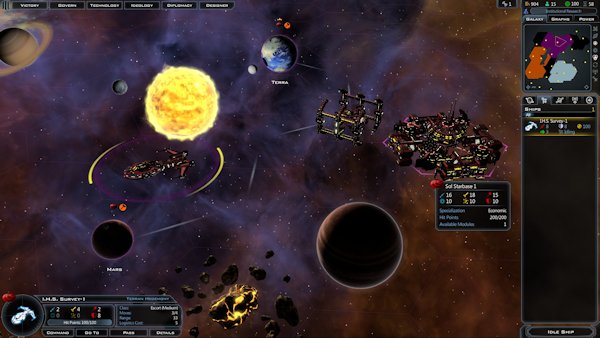
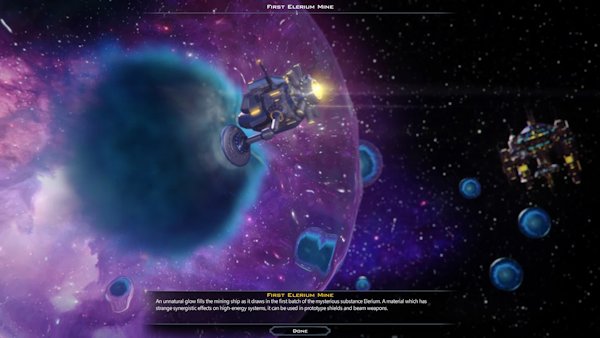
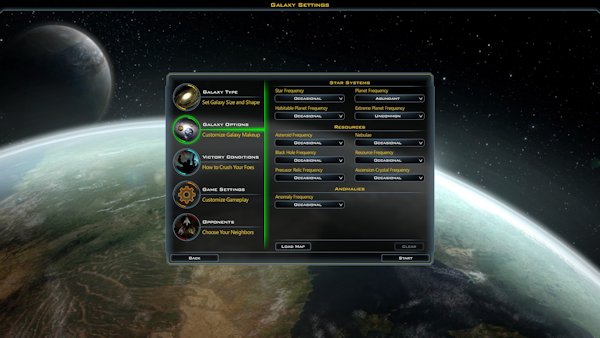
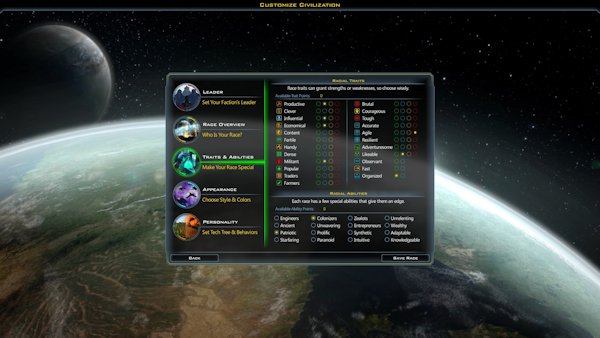
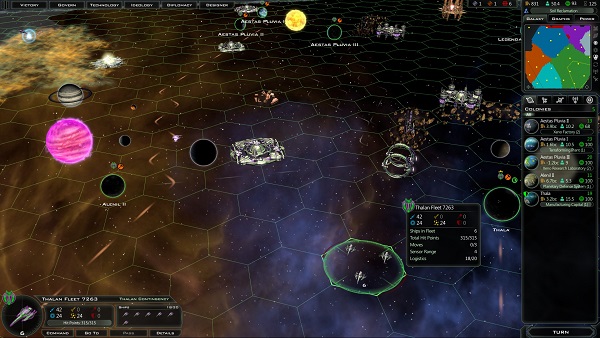
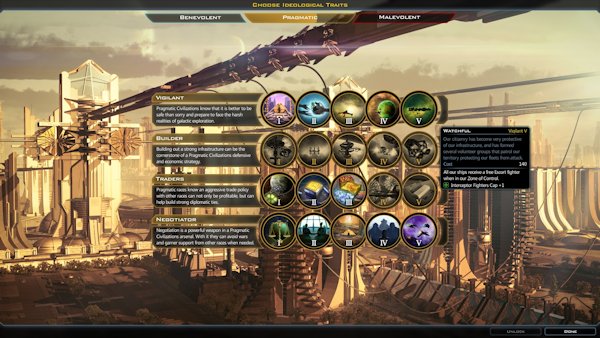
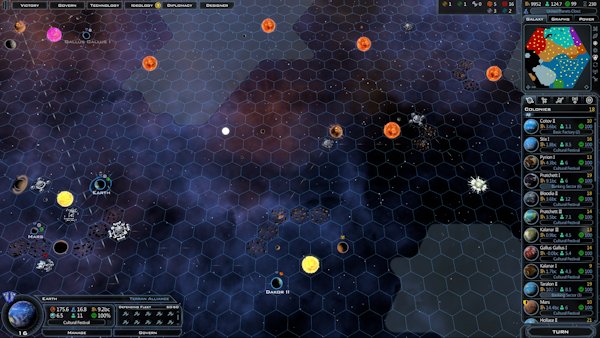
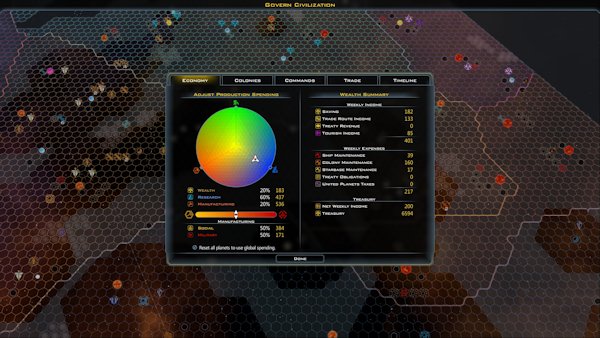
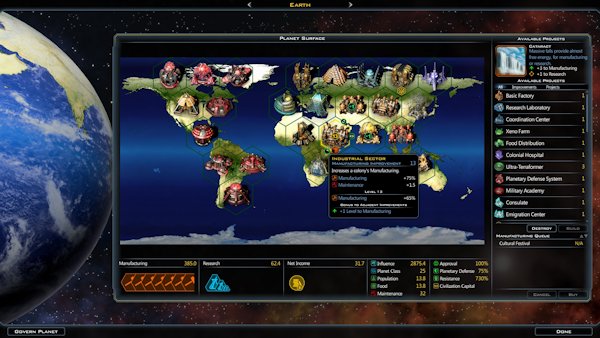
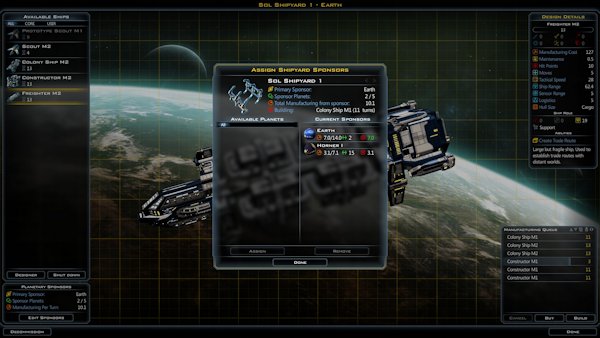
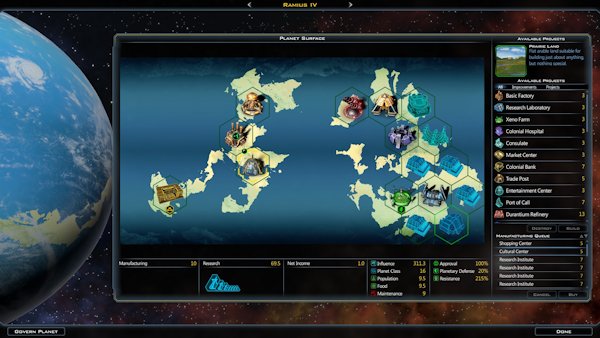
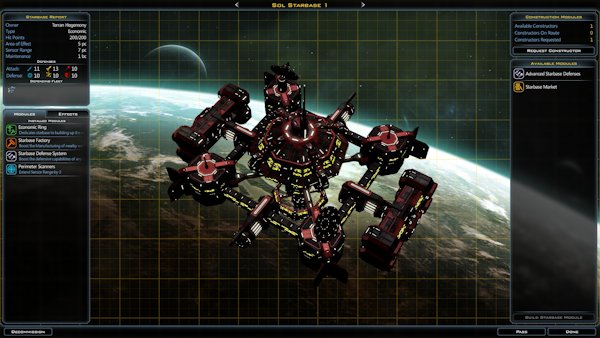
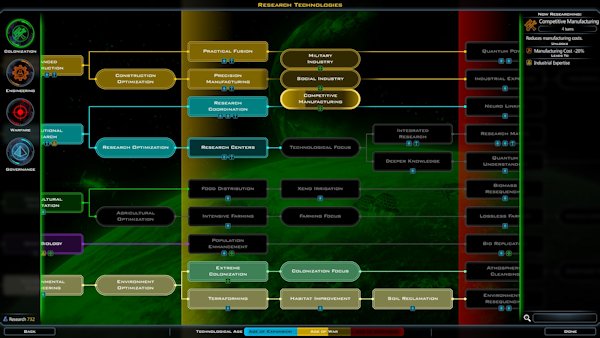
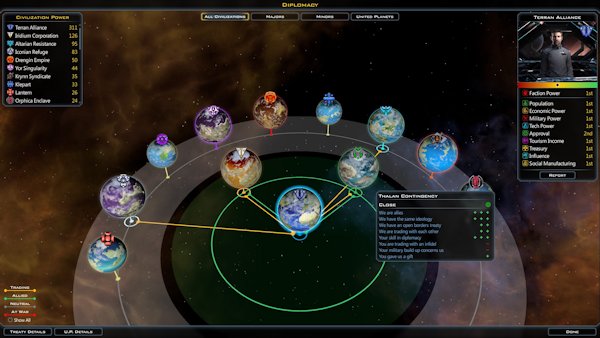

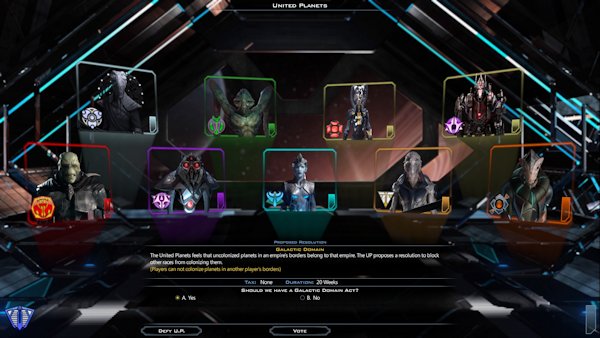
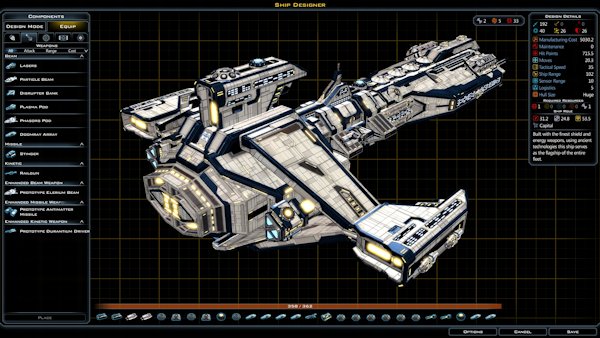
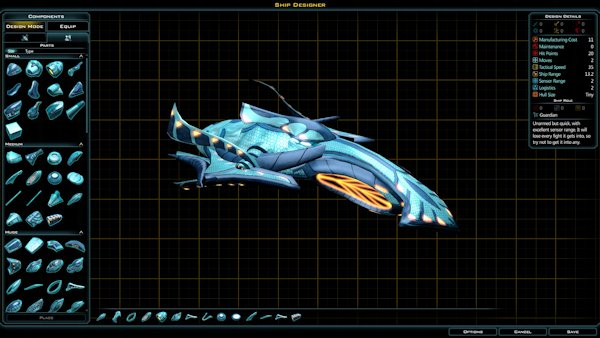
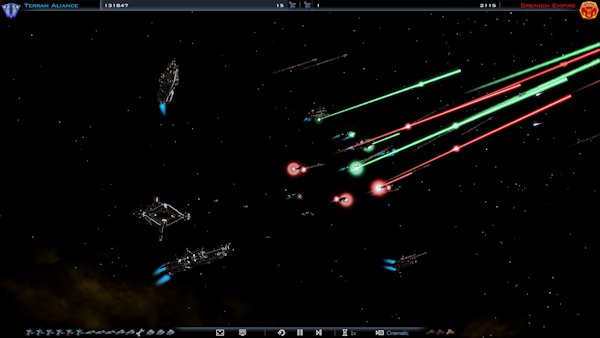
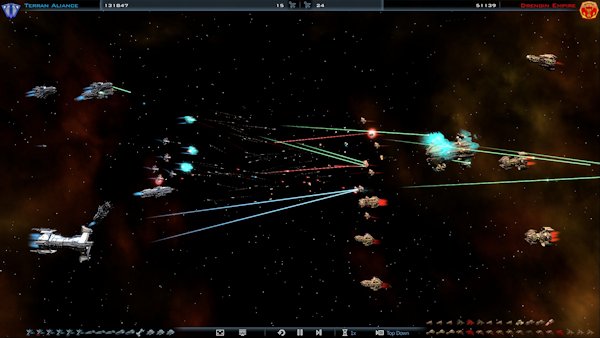
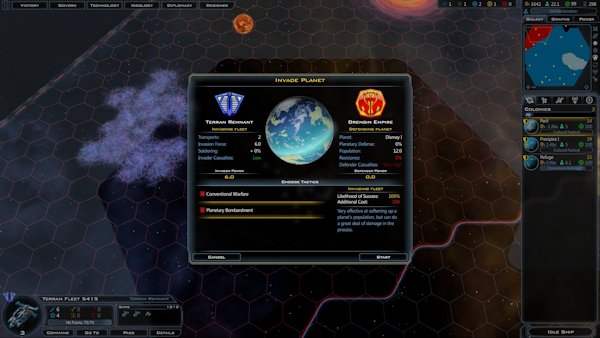
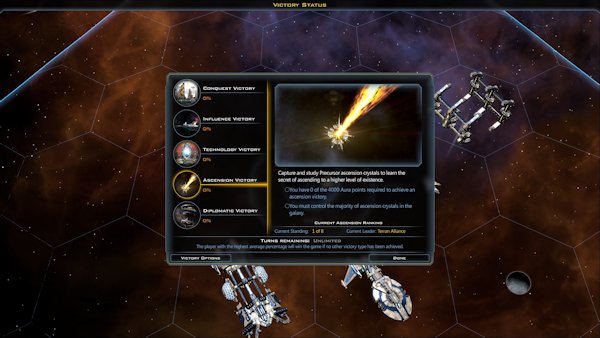
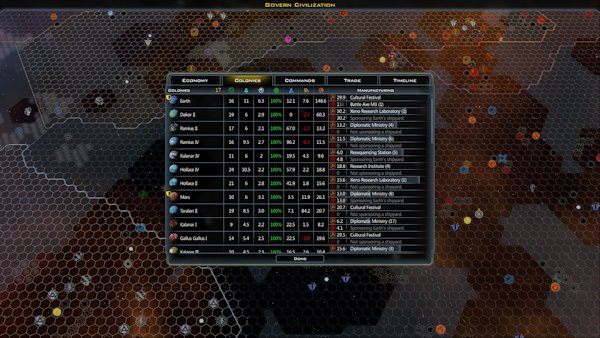
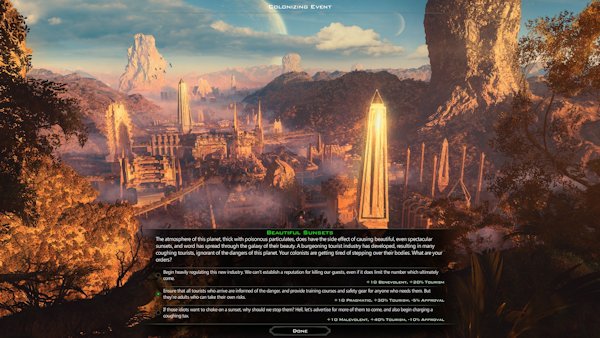




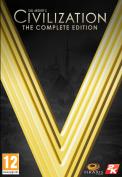


Another spot-on review from SS. Been playing since launch and everything talked about in this review pretty much encapsulates my thoughts on Gal Civ 3. For me, getting the game in its current state is like investing in the IP’s future. I know there will be some great expansions to come, so I’m hoping more depth will be a result from those expansions. Well, here’s hoping, anyway.
They say they are going to keep up development until 2020.
Also, on a separate note, now that I have played this game more, I think that there is one huge problem: Starbase constructor management can be micro-intensive, especially on large maps. It’s not a fun experience at all. It desperately needs to be changed.
Excellent, comprehensive review. In my opinion, the current price for the game ($50 on Steam) is much higher than I can justify spending, particularly considering its weaknesses. I understand that the developer needs to recoup its costs and realize a profit, but I’m in no hurry to buy. With all the discount and bundle sites, I’ll wait until the title has matured then buy it at a bargain price.
I’ve been a fan of the GC series since the original, and one of the trademarks of its developer (Stardock) has been receptiveness to user suggestions, and constant improvement of its products through frequent updates and expansions. Like Xyggy, I hope Stardock will continue that tradition.
Great read. I’ve successfully managed to not buy this so far and looks like I won’t anytime soon either. Needs two beefy expansions just like AoW3 to get my proper attention.
And I’m looking forward to that since there aren’t many space 4X’s with a good deal of depth in the management side of things (don’t mention DW, there are less management in that game with all auto-stuff turned off than in SOTS 1).
“(don’t mention DW, there are less management in that game with all auto-stuff turned off than in SOTS 1)”
Um, while there are several aspects in which SotS1 management is better than DW, I can hardly see how you can say that the management has less depth… Do you mean that the choices you make during management don’t have a meaningful impact?
Yeah I meant that; the resource system for instance, even after Legends expansion that made them not so abundant, it’s still all about looking at expansion planner and colonize the rare resources. Once you have them, you ignore it until you see them again in the expansion planner after which you just colonize a planet with that resource again. So a good system for giving a meaning to colonize certain planet types but there’s no real management involved.
Buildings are rare and play a modest role at best (rush wonders if you can, never build anything else unless you absolutely need it, they’re too expensive for what they do).
Tax/cash strategy is: set all planets to 0% tax all game until they have 1 billion pop or so, then start taxing it a bit.
Research – very little difference/variation between the races, game type, overall strategy – just research roughly the same stuff all the time and you’ll be fine.
Stations do require some strategy, especially those with docks so it does that better than Sots1.
Most of the management in DW is about planning taking care of all your different types of stations. Something that can somewhat cover up the oversimplified “ship design” with no real intellection involved.
The point is, in both games, once you’ve colonized a planet, you can forget it for a very long while. But thinking in between each tech/turn/year/milestone of what to do next considering the current situation, I do that more often in Sots1. Surprisingly enough. Or not when I think about it, I know why. So yeah DW “should” have more depth since it does have more “stuff”. But many of the stuff breaks down to simple choices you make every game. At least GalCiv has more “economic freedom” to really customize your empire.
Why do you call DW’s ship design “oversimplified”?
I’d say it’s among the most complex unit designs : not only few games have units composed (almost) entirely from components, even fewer of them have things like power, energy storage, acceleration, two different speeds for STL/FTL, and the order in which you build unit components mattering.
(One issue in DW is that the interface is lagging behind unit design features – for instance last time I checked there was no way to reorder the build order of components in a design.)
The biggest issue I’ve found with DW is that it’s economy is inconsistent :
tax rate is meaningless because you can transfer money from your private to your public sector at will by ordering civilian construction, and generally inconsistent are the different ways in how money is transferred or destroyed and related to resources.
One micromanagement issue in SotS1 is that if you want to grow your planets the most efficiently as you can, you have to move their terraforming/infrastructure building sliders so as not to waste any industrial output on infrastructure your lack of population prevents from operating.
Cannot reply to your comment..
—
You stack as many of your latest weapons as possible (all must be able to shoot with a bit of extra power). Stack armor/shields on ships with short range and keep them in front, have glass cannons in the back or just put a balanced mix of offense/defense so you don’t have to micro. That’s all you do all the time in DW. I fail to see how that’s “complex” in any way.
Power controls your ratio of weapons/shields vs speed/acceleration. It’s all about deciding which of the two/three roles I wrote above you want the ship to perform as and then “design” it as such, by stacking components as much as possible emphasizing the role of the ship, glass cannon or damage soaker or something in between. There’s no point of all those ship classes in DW at all. I have literally two, sometimes ONE military ship type for all my needs (pirates vs empires).
There are few (good)4x games with actual combat where only one ship type is needed and where all ship stats is promoting you to make that one/two or sometimes three ship types that does the same thing slightly different all game long. Unit components only matter in the construction process AFAIK so Idk how that’s any relevant.
The ship design in this game is very well representative of the rest of the game: lots of numbers everywhere, little actual room to do something different and to counter what the enemy is doing. So there’s little strategy involved in both ship design and the actual combat.
Oh, ok then, I haven’t played DW enough to have any meaningful space combat. So the same issue of lots of choices, but only few of which are actually meaningful?
This, however, is something that seems to plague all games tending towards “simulation” rather than “scripted design”…
Considering that DW was released 5 years ago already, weren’t there any mods released dealing with the issues you’re talking about?
I’ve honestly not played too many DW mods but from what I can see, the popular ones are Star trek, AI mod, extended mod and such. None of them changes the core of the game AFAIK probably because they can’t.
I really like the AI mod though, it’s fun because diplomacy isn’t really all that predictable in DW anymore. That’s quite a rare trait for any 4x game in my experience.
Also an AI might just conquer your planet without a DoW :D
There’s quite a bit of goodies like that under the hood of the AI in DW after all these expansions and patches. The AI(mod) is quite good for a 4x game and that’s huge.
The overall game play of DW after all these years is GREAT because it nails pretty much every aspect at least on a decent level. But it doesn’t have the last push to be a true legendary game (which no game qualifies as, not even MoO2 ;) ).
I was thinking more about mods introducing rock-paper-scissors mechanics into ship design, so that to hope to defeat an opponent you have to either bring overwhelming force against him (it), or study it’s ship designs and tactics carefully beforehand…
But I guess here you run into the issue that it’s hard to teach the AI to do the same thing against you.
Biggest flaw imo is making it appear too similar to GC2.
I bought this while it was 50% off. As the review hints, it’s basically what you’d expect from a sequel, but I think will need work to be truly outstanding.
One thing I really do like is that they made the game x64, which means that it won’t have RAM issues (GC2 tended to crash with mods due to too little RAM).
I’ll put more thoughts down later.
Okay my in depth thoughts.
GC3 was pretty much the most hyped space 4X game over the past year or so. Perhaps there was no real way barring a major leap forward for Stardock to have met the hype and that would have needed a much bigger budget.
I’m going to try to focus on things that were not addressed in Ed’s review. It’s very similar to GC2 and kept most of the best elements, as Ed has alluded to in review. They did expand on some areas such as good-neutral-evil has become more ideologically replaced.
What they did right:
+ Transition to 64 bit was a good call. Stardock has indicated that they will support this game until ~2020, which is about the same length as GC2. 2GB limits were an issue with modded GC2.
+ Stardock has made the game very mod supportive. The ship designer too has a lot of modding potential. There has also been integration into Steam Workshop.
+ I like the fact that there is support for more scale and size. Map sizes are much bigger than before.
+ Like before, the game has a pretty good AI compared to most 4X games. That’s harder to do than it sounds. Brad and his team has done a good job here.
What is still lacking in this game:
– The story line feels rather bland. It’s not nearly the rich engrossing story of say, Alpha Centauri. In this regard, I actually disagree with Ed on the cinematics – I would like to have seen more of them.
– Tactical combat is rather lacking. Personally I would have loved to see real-time tactical combat or something like what Age of Wonders 3 has (not sure how it would work in space, but it’d be pretty cool to try). They kept the elements from GC2, and although expanded somewhat, it’s still an underwhelming experience.
– I like the fact that they kept the different tech trees per species (introduced in Twilight of the Arnor) and the fact that each race has different UI/ship style, but there needs to be more difference between the factions.
– As Ed noted, ground combat really needs work. I have found that most space 4X games come up short on this.
Mixed:
– Although they did expand with the ideology, I feel like some things are shallow. Again, Alpha Centauri for example I like the Social Engineering part. I think that there should be a bit more emphasis on empire building, not just combat.
– Again, other parts like resources were expanded on (which is good in a way), but it still needs work.
Thoughts: I think that this is a decent start, but it’s going to need work. It is kind of like Age of Wonders 3 when it launched. Not a bad launch point, but has it’s flaws. Stardock has said they will be launching several expansions and DLCs for this game, so we’ll see what happens in the coming years.
If anyone wants my advice on whether to buy or not, it’s that you should consider it if it goes on sale.
the review is excellent. It points out almost everything I thought about the game.
Unfortunately the reviewer dont put enough emphasis on the fact that while in this game you can have alot of combat (I had games with 3-5 combats per gameturn) strangely it offers very weak space combat and even worse ground combat systems. This strong imbalance is IMO the biggest problem of galciv3. This problem opens up another can of worms because usually its not neccessary to construct many different ships for combat. Only a few big vessel blueprints with best weapon techs are sufficient. Additionally if you currently just have one enemy, it is enought to build just one type of ship which counters his ships and thats it. No necessity to build several combat types like in MOO2 or Space Empire IV. IMO its lame to have a shiny super ship contruction system and no good combat system to support the construction of different combat vessels.
At this price point I almost regret to have bought galciv3. I would not again make this mistake. Its a good game but the lack of interesting combat options makes it no classic. Maybe at 20 or 30 bucks.
Thank you for the comment :). Yes, you are right that there can be a lot of space combat in the game, up to 2-3 quite regularly and this on one of the smaller maps. The 3-5 ratio you say is quite easily achievable on normal maps.
There is an aspect I do disagree with you and it’s hinted at in the closing remarks, with a game with that many space battles even tactical junkies will auto-resolve en-masse. You’ll always have a few exceptions but it is very unlikely someone will spend 1 hour a turn fighting battles that have forlorn or obvious conclusions.
However, you do have critical battles that some do want to control manually, so definitely those that prefer that will not be too endeared to the game. This is why I made it clear the game does not have tactical combat, it’s said through-out the review.
I do apologise, but I don’t subscribe to the school of thought, “no tactical combat = bad”. It is just a strong personal preference that many have.
Mind you, I do understand this is a deal breaker for many, and thus I mention it clearly in my review.
Example: I loathe and despise open-world RPGs and refuse to even buy them. There is a lot of Western RPG fans out there eager and ready to argue with me that they are the best and only play open-world RPGs! A pointless argument really because I never claimed they were bad, just that I do not like them personally.
However, I do have to say, you can’t say I did not emphasis the ground combat is the pits, it’s both in the closing comment and one of the games negative aspects; and it also has this statement in its section:
“Not to be overly harsh, but this has to be the second most dull and uninspired planetary invasion system I’ve seen in a game since my tenure at SpaceSector. This would be forgivable if the second game didn’t actually do it “better” despite all the exploits the system had. At least this system is not as exploitable if one wants to have a silver lining. Flipping planets culturally is more interesting.”
I was comparing it to Lords of the Black Sun, a game I gave a 3.5 to. I am not sure what more you wanted? I slap the staff at Stardock with a fish across their face?*
*Disclaimer: SpaceSector and I do not endorse slapping developers across the face with fishes, anyone taking that quote out of context will be slapped across the face with a fish.
Since you’ve made the parallel yourself, do you think it would have been better if GalCiv3 didn’t have any ground combat whatsoever?
That would have been impossible. The game doesn’t have any planet glassing or planet killing (no spore ship or terror star). So without an invasion mechanic there would be no way to ‘beat’ your opponent in warfare.
A better term would be ground invasion mechanic (to avoid confusing it with games like StarDrive 2 that has a ground combat mini-game in it). Practically most space 4 game have some form of mechanic to resolve this. MOO 1&2 and even 3, GalCiv II and III (can’t recall what 1 did), and even LotBS and Horizon have a mechanic for invasion. So completely removing it would also be a step back IMO.
My point was, GalCiv III invasion mechanic was pretty poor. Removing it would be impossible and I don’t think GalCiv III taking the route of Galactic Inheritors of ‘glass them from orbit and then resettle’ would be a better alternative.
What would have been better is a better system, one that was an improvement over GalCiv II or something new that is more inspired. GalCiv III combat was a downgrade from II and since II wasn’t like the best of these mechanics, this was major flaw for me.
The system is dry, if that word makes any sense? This is due to the techs and mechanics involved. It’s all bare-bone ‘one-layer’ deep.
Well, the simplest solution would just be that if a player combat ship is in the same hex as an enemy planet, without any enemy space defenses, that planet is automatically captured.
That would certainly make you think twice before leaving a planet unguarded and your neighborhood un-scouted!
Another simple option is how Endless Space does (did) it, with ships having to stay at target for several turns (eventually with special components that speed things up – but we seem to approach GalCiv3 level of complexity here).
Well Endless space eventually (with the expansion) added bombardments and invasions.
Such mechanics though have their flaws, I quite liked actually. MOO 2 despite its flaws was one I always fancied as well. I would like to see a more modern variation of that.
I am not sure why more people don’t try to explore interesting ways of abstracting it. Instead, they either go bare-bone, or way over the top.
But you are right, a sort of ‘siege down’ mechanic for undefended planets, though even more abstracted would have been better. Personally, something that evolved over GalCiv II, or going along the lines of Endless Space: Harmony or even MOO 2, would have been preferred IMO.
Ground combat may be poor in GCIII, but it is entirely missing from the SOTS series. In SOTS prime, you could either glass the planet and recolonize, or with appropriate research, you had the option of accepting the planet’s surrender just before the population was exterminated. You still had to colonize the planet, but your new colony had a jump-start with the remaining population and infrastructure of the previous occupant. For reasons I can’t fathom, that feature was eliminated in SOTS II.
There’s also the Assimilation Plague (very effective, but a high-end tech you’re not certain to get (unless you’re Zuul, then all your ships carry it)) that converts the population of the planet and terraforms it for you.
AFAIK, the feature of keeping civilians on colonization is present in SotS2 too.
One of the game concepts that keeps me away from GC III is “do or die” battle mechanism. I mean the lack of retreat from battle option or automatic remnants escape. It harms the RPG factor significantly.
Sometimes less is not more.
^This
Something I just posted on my blog yesterday actually that I keep wishing for when I play GCIII and most other 4x games. You can’t have skirmishes or testing of strength without risking\losing your ships anyway… even retreat options that are in games with tactical combat are often heavily penalized which I understand is needed to balance it but still ends up been most combat is win or die.
The only mechanic that I know avoids these problems is Civ V style (doesn’t have to be one-unit per tile though), which is what I’m aiming for in my project. I guess star ruler or other RTS 4x can avoid it but only if combat is done on the tactical map and personally I just prefer TBS a lot more.
I think if you want to tactical combat you will most often get a do or die combat mechanic, because lets face it you don’t want to have to keep going in and out (and loading) of tactical combat screen as you do a little damage and then someone retreats…
GC3 probably is stuck with the Do or Die mechanic because of the battle viewer, again you don’t want to load a battle view to get a few shots of then wait till next turn load the viewer and exchange fire again.
I am always hopeful for another space 4X that doesn’t need a do or die combat mechanic :)
http://kwflgames.blogspot.com.au
I don’t remember any games with instanced combat where the AI knew how to use retreat well, if at all!
(except maybe in HoMM games, but it’s a bit different, since you do keep your hero and artifacts, but lose all your remaining army)
Retreat can be abused, but it’s one of those additional layers that make the combat more interesting and that feel great when you manage to pull off your strategy (an example, HoMM again : the infamous armageddon+retreat tactic)… and in multiplayer, it’s always better to lay some ground rules of what is and what isn’t allowed
(another related example is agreeing when kiting and not using auto-resolve (or time compression) is allowed, as these can be HUGE timewastes).
Good point with the AI weaknesses (how much longer ;), but on the other hand characters and fleets (and mainly the characters within the fleets ;) are the crucial factors that give the game any plot and RPGish depth.
Let’s fantasize: Heavily damaged or captured capital ship as well as wounded or imprisoned character could be the fine spoil for the winner and the important reason for revenge mission for the loser.
I was thinking more on the line of strategic/operational/tactical depth, but I do see how you could potentially make a good empire/fleet combat/admiral focused game (however, the empire side would have to be even more subdued than, say, in Sword of the Stars 1).
Wait, doesn’t that pretty much describe Haegemonia?
I’ve mentioned this in other posts, but Space Empires V handles ship-to-ship combat in a unique way. Tactical combat occurs on a large 2D “battlefield”, with each side starting close to the center. Combat is in real-time, and although you don’t directly control your ships, you can broadly influence the fight (direction of flight, primary targets, formation, etc.) Combat lasts a player-set number of minutes and if you manage to get your ships to reach the outer boundary of the field before time expires, they have “retreated.”
Even more interesting, the ship designer has a testing module: design a ship and engage in simulated combat against any other ship/station/planet on the same battlefield used in actual combat.
Space Empire V had plenty of development problems, and its AI is notoriously bad, but its ship designer, combat test module, and tactical combat were refreshingly different. I’m a little surprised no other developer emulated those ideas.
Even before SE5 (2006) wasn’t there Total War (among others?) that used a similar kind of combat?
And since then, there were several empire games, specifically space ones, that used this kind of combat, for instance Sword of the Stars 1 (2006), Sword of the Stars 2 (2011), StarDrive 2 (2015).
I’m not sure if a ship designer with a 2/3D component layout was ever used before SE5 (then, it’s not like I’ve played all empire games, especially the earlier ones), but it was used in multiple games since then, for instance Star Ruler 1 (2010), Star Ruler 2 (2015), StarDrive 1 (2013), StarDrive 2 (2015).
SE5 is best played with mods like Balance Mod, that solve many of its problems (including making AI a lot better).
Technically I suppose you could save the game and try battling, but that’s tedious I guess.
Not to mention unlikely to be allowed to do in multiplayer…
One point i loved in Space Empires V (didn’t play IV), was the option to set up battles between your blueprints and the known ships of the others. good for testing your setups, but the real battles still kept different because of some merits and flaws of the factions. i miss this options in all the other 4X games.
There were not one, but TWO empire games featuring battle arenas released this year (within a months of one another, to boot) : Star Ruler 2 and StarDrive 2.
BlueTemplar: “There were not one, but TWO empire games featuring battle arenas released this year (within a months of one another, to boot) : Star Ruler 2 and StarDrive 2.”
Huh; I didn’t know that. Thanks for the info.
I bought it, I played it, I went back to Distant Worlds.
The bar has been raised and Gal Civ III doesn’t come close.
You seem to forget the most important aspect of a tech tree : it doesn’t matter how tech A is linked to tech B (if at all) : if techs costs are defined per-tech, tech B costs 1000 times more points than tech A and tech B isn’t a pre-requisite to tech A, then any player with minimal experience will research tech A before tech B. The tiers are then built inside the tech costs.
Also, I feel it’s a bit a shame the way they made Ideology work : after all, it’s just a second kind of tech tree (the defining aspect of a tech tree here being its inability to lock things again once they have been unlocked), even though its “research points” are unlocked in a different way.
Plus, it’s not even a new concept anymore (Civ:BE has THREE of such unlockable “tech trees”).
I feel that the social engineering mechanics like in Alpha Centauri, Civilization 4, or even Endless Legend (in the form of the Empire Plan), where a new “policy” is not automatically better (and is often worse if you haven’t planned for it), and where you can always go back to a previous “policy” – are much more interesting.
I agree.
I once made a similar comment about why I preferred the Civ IV Civics over Civ V Social Policy (and by extension BE’s Virtues).
Civ IV Civics were certainly heavily influenced by SMAC’s Social Engineering.
A game dev friend of mine said there is a good chance the Virtue and Social Policy system along with even the Ideology Tree from GC3 are RPG elements. Skill trees or talent trees are common in CRPGs. Culture and Ideology is basically XP in that regard in these games. Which is similar to Tech really, it merely is another type of “XP” that is accumulated and spend differently.
By no means I consider the system intrinsically bad, but I preferred the Civ IV way of doing it.
The “walled-garden” nature of Steam Workshop is a potential issue (if the game is ever published outside of Steam).
So, how well can you see how your ship layout and fleet composition choices affect the combat replay?
This is a huge issue in Endless Space, IMHO.
The battle are calculated based on weapons stats so it’s pure, dispassionate math. More ships means more weapons means win. Fleet composition, positioning, ‘terrain’, tactics or whatever doesn’t matter. It’s like combat in CIV game. The game knows exactly what the variables are and just give you one final result.
Why do you think Ed mentioned without fleet cap, the fleet with the most ship would almost always win.
At least ES has engagement distance and tactical cards to mix things up a bit. GalCiv 3 is basically cashing in on nostalgia and the brand name.
Don’t they, really? I don’t agree with you, all these things very much matter in (most?) Civ games… I have a hard time to believe they bothered to introduce all those features in GalCiv3 (which do include weapon range?) for them not to have any actual effect on combat!
Overhyped and overscored by the press.I am sure it could be good with expansions but as it stands the games bland with no imagination and terrible combat.The A.I is very weak militarily and falls like a pack of cards too.
This game is no more than a 7.EndlessSpace was better.DW is miles ahead.
Well, looking at the statistics :
Metacritic critic score : 82/100 (22 critics), game 501/3004 (83%)
Metacritic user score : 6.8/10 (155 ratings), game 1920/2861 (33%)
Steam user reviews : 74% (of 1758), page 133/224 (41%)
Indeed…
I was discussing this with someone and was avoiding the easy accusation most people tend to go for. This is partially due to not seeing any evidence of it for this case and partially due to Hanlon’s Razor.
I actually have two somewhat simple explanations that stays true to Hanlon’s Razor.
I think a lot of official reviewers tend to be easily seduced by high production value and presentation game. The nicer a game looks the more easily they forgive it’s short comings. Actually, some sites give graphics about the same weight as the other categories and only have a few categories. Though visual should also include art styles and aesthetics, but all too often it becomes merely “better graphics” for many. I can understand being visually appealing is a good thing, and I rarely deny that, but a game is more than just visual porn.
I was involved with more than one site’s discussion about review score reforms and generally speaking “averaging the categories” or having straight-jacket categories are bad were the most common arguments we had. The legacy of some of the worst review scoring systems I’ve seen in my life still plagues many ‘reviewers’ to this day. I actually left more than one site because of these disagreements.
The second explanation that I think applies the most here is that many of these people either never played GalCiv II and this was a new experience for them, or review like GalCiv II never existed even if they refer to it. Though I am first to admit that games should be reviewed on their own merit and that a sub-genre or style is superior to another; sequels and franchises need to do more than just recreate a more polished experience.
This is probably why quite a few games get overhyped and meet adulation from some while many are not certain why the game was so well received by the first group.
I’m not certain Ashbery76 meant to say there was a malicious intention involved…
Overscored is very clear from those statistics, and overhyped most likely results both from GalCiv2 being very popular (for a space empire game), as well as probably from a much higher than average (again, for a space empire game) advertising budget.
I feel that Steam user reviews are going in the right direction :
– a clear “either you recommend the game, or you don’t” system (that prevents 0/10 scores weighting more than 10/10 when the median score for games in general is much higher than 5/10)
– which is then nuanced by the review itself, with the “most helpful” reviews rising to the top (as well as reviews of your friends (?) / people that like the same things as you (?))
Another thing I suspect, a lot of times they only play 10-20 hours top before doing the review. Combine that with the above two and you can see why it happens.
A lot of the more critical reviews come from people who played over 50+ hours, some even over 100 hours. You still have a few that didn’t like it right out of the door and that opinion matters as well, but a lot of the most helpful negative Steam reviews have 50+ hours under their belt.
Personally, I sunk a little over 100 hours post release with an extra 20 or so hour in beta.
I think when it comes to a 4X game, I think one needs to play them for over 50 hours to make a full review if the 20 or less hours impression was good. The reverse is not true, if under 20 hours you are still not sold, it won’t sell itself after 50 hours. However, you can’t let the first 2-3 hours set your final impression either (though that might indicate certain issues with the early game or learning curve).
My recommendation for ‘pro’ reviewers: get over the learning curve, play several full games (they can be short), then if the game feels good play at least one if not more long games. The more you like it, the more you play it and be critical of the issues you notice as you keep playing it. This will help pick out the issues others might find when they play.
I don’t think 4X games can be sized up quickly unless they are terri-bad. The most common complaint I hear lately is how quickly a game gets stale or boring. For the genre that coined, “one more turn,” this is very bad as replayability has always been very important for this genre.
Very good points, especially about the dis-symmetry between having to play the game for at least 50 hours to be sure it’s good, but still at least 20 hours to be sure it’s bad.
The actual number of hours needed is probably related to the actual expected overall playtime of the game (which tends to be in hundreds or even thousands of hours for an empire game, while much lower for something like Portal 1 (then you have also take modding into account, and it gets complicated…)).
Colour me disappointed. I was looking forward to this game, but admit I like a little more meat on my combat.
Somebody remake Birth of The Federation ;-)
I really liked BotF. Combat was wonky, but it did a lot things well. A pity the game never got enough post release support since it had a nasty memory leak issue.
With the resurgence of the 4X genre along with other strategy genres, I’m hoping someone will eventually look back to that game or do something with the IP.
Thanks for the spot on review! I was actually really looking forward to it, as I managed to play the game a bit and found that no review from any “big” site pointed out the flaws of the game, everybody was just ecstatic about it! I liked the game but I’ll wait before buying it, until it’s quite fleshed out. No governors for planets make middle to late game management a real chore (I like playing on large maps), i just couldn’t finish my game as I found it too tedious…
You really are my reference for 4x games (and i managed to get you referenced in Paris’s libraries online catalogue by the way ;) )
Please go on you’re the best!!!
This might be a false assumption on my part but Stardock has a very diverse portfolio and they offer a lot of software that isn’t gaming related (unlike a pure game studio). As a result, I get the impression that they are a software company first and a game developer second and it shows with the games they develop.
Galciv III, perfect example. A nice, safe, bland game designed to wow with graphics, seduce both brain cells of most mainstream reviewers and sell lots of copies to bring the $$. God forbid they innovate anything in their games that enhances the gameplay but by all means lets add in the pointless and mostly graphical ship design feature that will wow everyone. Oh yea, and we did say we would improve combat in GalCiv III so let’s throw in half azz ship roles and a few weapon ranges and call it good.
Just not enough there to justify their asking price. It’s more like Gal Civ 2.5. They really need to abandon that flat universe it offers up, it’s too much of a board game like feel. The universe if flat,, you get a flat view of your planets. Flat,,Flat,, Flat.. Old MOO2 gave you a feel you were landing on a planet and gave you a view of your buildings etc.. Good AI planet governors is missing and that’s also surprising. As many mentioned, too many Web site reviewers did not play a long game before giving their ratings or it would of been lower.. Gal Civ 2 was a well made game for what it offers, I was not looking for Stardock to reinvent the wheel with version 3, just wanted a more immersive and fun experience and was less repetitive than the previous version.
I concur, I really am not even sure I will ever pick this one up. GalCiv2 was already quite stale for me to even keep playing more than a few days.
So if this got a 7.8 then it is definitely not going to be on the cards for me, unless a year out I see it in a bargain bin for $10.
Well heres waiting for what the new Masters of Orion game comes up with, otherwise there is always Stellaris. ^^
Update – increasingly I feel like this game was not the ready for release at the time it was released.
It needed a lot more polish than was actually present. Going back on the Stardock forums, a lot of forum members were shocked when they learned of the release and felt it was not ready.
As others have noted, there seem to be a higher percentage of negative reviews from the people who have spent more hours in the game than most reviewers have.
I’ll also note that the AI was not as good as I thought it was on release. Interestingly enough, even Brad himself rated it 6/10. It’s one of those things I guess that made a good impression at first, but when you put in more hours, you realize the unfortunate reality.
The game is quite micro-intensive with constructors and needs other changes too.
I’d say, either get this one sale or wait a few expansions.
Hi,
Will it playable on this NB?
W7 – 64b, 8 GB RAM, Intel I7-3610QM, dedicatid grafic card NVidia GT 650M/2 GB GDDR5.
Thanx for reply.